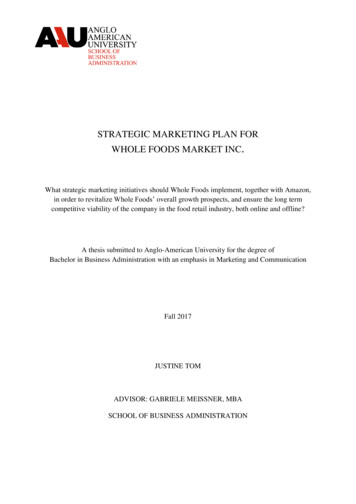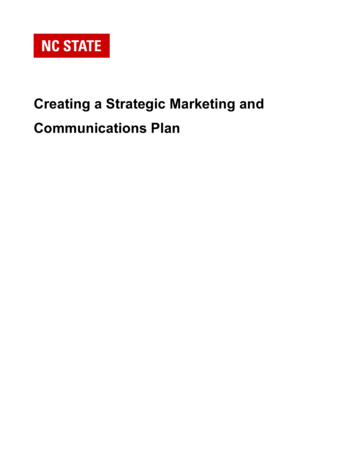
Transcription
STRATEGIC MARKETING PLAN FORWHOLE FOODS MARKET INC.What strategic marketing initiatives should Whole Foods implement, together with Amazon,in order to revitalize Whole Foods’ overall growth prospects, and ensure the long termcompetitive viability of the company in the food retail industry, both online and offline?A thesis submitted to Anglo-American University for the degree ofBachelor in Business Administration with an emphasis in Marketing and CommunicationFall 2017JUSTINE TOMADVISOR: GABRIELE MEISSNER, MBASCHOOL OF BUSINESS ADMINISTRATION
DECLARATIONI hereby declare that no portion of the work referred to in this thesis has been submitted insupport of an application for another degree, or qualification thereof, or for any otheruniversity or institute of learning.I declare that this is my independent work. All sources and literature are cited and included.I hereby acknowledge that my thesis will be made publicly available pursuant to section 47bof Act No. 552/2005 Coll. and AAU’s internal regulations.JUSTINE TOMi
ACKNOWLEDGEMENTSI would like to sincerely thank Gabriele Meissner, my thesis advisor and instructor for severalcourses here at AAU, for being so committed, and devoting so much of her time to helping mewith my thesis. I would also like to thank to Chris Shallow and David Muir, for their time andeffort they have put into helping me to perform to the best of my abilities.I would also like to thank Kristian Pankulych for being a supporting factor throughouteverything.Most importantly, I would like to thank my parents and sisters for their unconditional loveand support. I wouldn’t be where I am today if it wasn’t for them.- Justineii
ABSTRACTStrategic Marketing Plan for Whole Foods Market Inc.Author: Justine Tom, Business Administration with an emphasis in Marketing andCommunication, Anglo-American University, Prague.Most industries have undertaken digitalization efforts to varying degrees in recent years.Some traditional ones however, have resisted or have been unable to devise a breakthroughstrategy that addresses the needs of the customer and retain a personalized and qualityshopping experience. The grocery industry has long established itself as such an industry,unable to convince shoppers to fully switch to online grocery shopping and delivery. WholeFoods Market, a premium grocery retailer offering quality natural and organic products maypresent itself as the company able to make the digital breakthrough in its industry. While thecompany enjoyed some success from its inception, introducing consumers to healthierproducts and popularizing the organic food trend, it has fallen by the wayside in recent years,flagging behind other competitors that have emulated their strategy while offering comparableproducts at lower prices. Following the recent acquisition of Whole Foods by global ecommerce giant Amazon, the company stands to completely revitalize its business model,through the creation of a multi-channel customer centric shopping experience, harnessingAmazon’s digitalization and data mining capabilities, and targeting urban areas in line withcustomer trends. To achieve this will require a careful balancing act of managing organic foodsuppliers to build key relationships, and handling the post-merger integration of bothcompany cultures. On the opposite end, Amazon’s likely rationale for acquiring Whole Foodsis to develop expertise in food delivery and integrating Whole Foods into its overalldigitalization strategy.This thesis aims to examine Whole Foods’ marketing strategy, financial performance, as wellas the effects of the acquisition by Amazon, both real and speculative, supported by carefulanalysis. Based on these attributes, the set of recommendations was designed to reinforceWhole Foods’ position as the premier grocery retailer providing both an online and offlinecustomer centric experience.iii
TABLE OF CONTENTSCHAPTER 1: INTRODUCTION . 11.1 Industry Overview . 11.2 Historical Background. 11.3 Company Background Information . 21.4 Personal Interest . 21.5 Purpose . 31.6 Conceptual Framework . 31.7 Methodology . 31.8 Statement of Sources Cited and Consulted . 41.9 Structure of Thesis . 4CHAPTER 2: LITERATURE REVIEW . 62.1 Marketing Strategy . 62.2 Food Retail Industry . 62.3 The Organic Food Industry . 8CHAPTER 3: MARKETING AUDIT . 93.1 PLEESTIC . 93.2 SWOT Analysis. 103.3 TOWS Matrix . 113.4 Porter’s Five Forces Framework . 113.5 Porter’s Value Chain Analysis . 123.6 Competitive Profile Matrix . 133.7 Business Model Canvas . 143.8 Acquisition . 15CHAPTER 4: ASSUMPTIONS . 16CHAPTER 5: STRATEGIC MARKETING PLAN . 175.1 Corporate Strategy. 175.2 Markets and Segments . 175.2.1 Macro Analysis . 185.2.2 Micro Analysis . 185.2.3 Current State of the Market . 195.2.4 Market Trends . 195.2.5 Competitor Analysis . 205.3 Products / Services . 215.4 Marketing Objectives . 215.5 Marketing Strategies . 225.5.1 Porter’s Competitive Advantage Grid . 225.5.2 Segmentation & Targeting . 235.5.3 Differentiation . 245.5.4 Positioning . 245.6 Gap Analysis . 255.7 Product Strategies . 265.7.1 Product Management. 265.7.2 Product Life Cycle . 275.8 Price Strategies . 275.7 Place Strategies . 285.7.1 Distribution Strategies . 285.7.2 Relationship Marketing . 28iv
5.9 Marketing Communications Strategies . 295.10 Direct and Interactive Marketing Strategies . 305.11 Sales Strategies . 305.12 Ethical Considerations/ Ethical Audit . 305.13 Implementation. 315.14 Internal Marketing . 325.15 Branding Strategy . 325.16 Monitoring and Control . 325.17 Recommendations and Conclusion . 32CHAPTER 6: EVALUATION OF THE CURRENT SMP . 346.1 Corroboration of Thesis . 35CHAPTER 7: FINANCIAL ANALYSIS . 367.1 Revenue and Income Analysis . 367.2 Profitability Ratios . 397.3 Liquidity Ratios . 427.4 Leverage Ratios . 437.5 Efficiency Ratios . 437.6 Stock Performance . 457.7 Additional . 467.8 Financial Impact of Acquisition for Amazon . 467.9 Financial Analysis Conclusion . 47CHAPTER 8: DISCUSSION . 488.1 Strategic Recommendations . 48CHAPTER 9: CONCLUSION . 549.2 Research Limitations . 549.3 Suggestions for Future Research . 55WORKS CITED . 56BIBLIOGRAPHY . 64APPENDICES . 66Appendix A: Extended Organic Food Industry Overview . 66Appendix B: Extended PLEESTIC Analysis . 67Appendix C: Extended SWOT Analysis . 68Appendix D: Whole Foods Market - TOWS Matrix. 70Appendix E: Extended Porter’s Five Forces Framework . 71Appendix F: Extended Value Chain Analysis . 72Appendix G: Evaluation of Whole Foods’ Competitive Profile Matrix . 73Appendix H: Extended Business Model Canvas. 74Appendix I: Value Proposition Canvas . 77Appendix J: Acquisition . 78Appendix K: Expanded Micro-Analysis . 79Appendix L: Extended Targeting & Segmentation Strategy. 80Appendix M: Organic Labelling Practices in the U.S. . 82Appendix N: Whole Foods Extended Product Management Analysis . 83Appendix O: Whole Foods’ Product Life Cycle Analysis . 85Appendix P: Extended Distribution Strategy . 86Appendix Q: Whole Foods’ Extended Marketing Communications Strategies. 87Appendix R: Whole Foods’ extended Branding Strategy . 89v
LIST OF ABBREVIATIONSATR – asset turnover ratioCSF – Critical Success Factoribid. – ibidem, reference source previously usedITR – inventory turnover ration.d. – no daten.p. – no pageM&A – mergers and acquisitionsPLC – product life cycleROA – return on assetsROE – return on equitySGA Costs – Selling, General, and Administrative CostsSKU – stock keeping unitSMP – Strategic Marketing PlanVPC – Value Proposition CanvasWFM – Whole Foods Marketvi
LIST OF FIGURESUnless otherwise indicated, all figures in this thesis are created with Sketch or Word byJustine Tom, Anglo-American University, Prague 2017.Figure 1: Marketing Strategy . 6Figure 2: U.S. Grocery Market Share in 2016 . 7Figure 3: Composition of Organic Food Purchasing Locations in the United States . 8Figure 4: Porter's Five Forces Framework of WFM . 12Figure 5: Whole Foods Market Value Chain . 13Figure 6: Factors influencing the macro environment . 18Figure 7: Whole Foods' Strategic Group Map . 20Figure 8: Porter's competitive advantage grid . 23Figure 9: Whole Foods' Perceptual Map . 25Figure 10: Moore’s Value Disciplines and the Lifecycle. 27Figure 11: Whole Foods’ Marketing Expenses as a % of Sales . 29Figure 12: Advantages and disadvantages of WFM's SMP . 34Figure 13: Whole Foods Market Total Revenues and Percentage Growth 2012-2017. 37Figure 14:Whole Foods Market same-store sales growth, year on year . 37Figure 15: Selling, General, and Administrative Expenses as a % of Net Sales . 38Figure 16: Year-to-year price change comparison of retail food price deflation from 20082017 . 39Figure 17: WFM and competitors' ROA & ROE Comparison . 41Figure 18: Whole Foods - Shares Repurchased . 41Figure 19: Whole Foods' pricing power over the past 10 years . 41Figure 20: Whole Foods - Stock Performance . 45Figure 21: Graphical representation of Whole Foods' potential platform-based ecosystem. 50Figure 22: Whole Foods' Value Proposition Canvas . 77Figure 23: Selected Whole Foods store brands . 84Figure 24: Whole Foods Market Ad Examples . 88Figure 25: Brand Intimacy in Retailing: Amazon vs. Whole Foods . 89vii
LIST OF TABLESUnless otherwise indicated, all tables in this thesis are created by Justine Tom, AngloAmerican University, Prague 2017.Table 1: Company Background Information . 2Table 2: PLEESTIC Analysis . 9Table 3: WFM SWOT Analysis . 10Table 4: Competitive Profile Matrix Whole Foods Market . 13Table 5: WFM Business Model Canvas . 14Table 6: WMF - Market trends . 19Table 7: Whole Foods - Gap Analysis . 26Table 8: Whole Foods Market Key Numbers Income Statement . 36Table 9: Profitability Ratios for Whole Foods Market 2013-2016 . 40Table 10: Revenues and Profit Margins WFM and competitors . 42Table 11: Liquidity Ratios. 43Table 12: Quick Ratio - Competitive Comparison. 43Table 13: Leverage Ratios. 43Table 14: Efficiency Ratios . 44Table 15: Inventory turnover - Competitors. 44Table 16: Whole Foods Stock Performance Progression in . 46Table 17: Evaluation of Recommendations . 53Table 18: Whole Foods Market - TOWS Matrix . 70Table 19: Porter's Five Forces Framework - Brief Explanations . 71Table 20: Whole Foods Market - Market Segmentation . 80viii
CHAPTER 1: INTRODUCTIONThis thesis will examine Whole Foods Market Inc. (henceforth known as Whole Foodsor WFM), its marketing strategy, financial health, and the internal and external forces thataffect the company. Following the analysis, several key strategic (marketing) issues have beenidentified, and these will serve as the basis for a newly suggested Strategic Marketing Planthat has been developed for Whole Foods Market by the researcher of the thesis.The research is up-to-date to 24/11/2017.1.1 Industry OverviewThe food and staples retailing sector in the United States can be described as a highlycompetitive and saturated market with razor-thin margins and a customer base which isconstantly demanding greater value for lower prices. Some of the categories within thisindustry include Drug Retail, Food Retail, Hypermarkets and Food Distributors. Examiningfood retail at a closer glance, several key developments can be observed that are changingcustomer tastes and preferences, such as the rise of e-commerce, the increasing popularity ofalternative channels, and shifting demographics (Duff&Phelps, 2016, p.3).1.2 Historical BackgroundWhole Foods Market is a high-end natural and organic food retailer which operates inthe United States, Canada, and the United Kingdom. Whole Foods Market was founded in1980 by John Mackey, Renee Hardy, Craig Weller, and Mark Skiles, in Austin, Texas,following a merger of two small natural foods stores: Safer Way Natural Foods, andClarksville Natural Grocery (Wholefoodsmarket.com, n.d., n.p.). Whole Foods Market hasbeen able to grow after various strategic mergers and acquisitions of natural food storesthroughout the United States. In 2002, Whole Foods entered the Canadian market andacquired seven Fresh & Wild stores in the U.K in 2007 (ibid.). This paper will predominantlyfocus on the company’s U.S. operations, since this market accounts for 97.1% (2016) ofWhole Foods’ revenue (Whole Foods Market, 2016, p.39).1
1.3 Company Background InformationTable 1: Company Background InformationNameWhole Foods Market Inc.Corporate StructurePublicSubsidiaryFoundedWholly-owned subsidiary of Amazon.comInc.1980HeadquartersAustin, Texas, USAIndustryTotal employeesFood & Staples Retail – Organic &Specialty Retailing86,645Total Revenue 14.9 billionBoard of DirectorsCEO - John MackeyCo-CEO - Walter RobbPresident and COO - A.C. GalloExecutive Vice President and CFO - GlendaFlanaganExecutive Vice President of Growth andBusiness Development - James SudExecutive Vice President of Operations David Lannon Executive Vice President of Operations –Christina MinardiExecutive Vice President and ChiefInformation Officer - Jason Buechel(Information taken from Whole Foods Market - Annual Report, 2016)1.4 Personal InterestWhole Foods was selected based on the researcher’s interest in the organic foodindustry. According to the Organic Trade Association (2017), organic food accounts for morethan 5% of the total food sales in the United States, with the market growing at a rate of 8%from the past year, making it the fastest growing sector in the food industry (OTA, 2017, n.p)One of the main drivers of growth in the organic sector can be attributed to the changingtastes and preferences of U.S. consumers (Duff&Phelps, 2016, p.5). Shoppers are becoming2
increasingly conscious about their health and the environmental impact of food (ibid.). Therecent turn of events raises several interesting questions, namely, why has Whole Foodsexperienced such a dramatic decline in fortunes, and what does this takeover mean for thefuture of the company and the industry?1.5 PurposeThis thesis will examine the marketing strategy of Whole Foods, as well as itsfinancial performance. The relationship between these two elements will also be explored, inregard to the extent that the marketing strategy affects financial performance. Additionally, anindustry report will be created to study the external factors which have a considerableinfluence on Whole Foods’ operations including competitors, retail trends, and demographicchanges. An additional chapter will be dedicated to the recent acquisition of Whole Foods byAmazon, outlining the motivations behind the move, the future prospects of the firm, as wellas the potential consequences.1.6 Conceptual FrameworkThe conceptual framework used to develop this thesis can be divided into three mainstages. The first stage consists of gathering secondary data such as academic journals andarticles, credible digital sources, industry reports, and books. The second stage focuses onanalyzing the information to outline Whole Foods’ current strategic marketing plan (SMP),using the relevant marketing analysis tools. Based on this analysis, a new SMP will berecommended, in the third stage.1.7 MethodologyThe data used to analyze Whole Foods was gathered through four types of marketingresearch. Marketing Research can be defined as the methodical gathering, analyzing, andpresenting of data related to a marketing problem or phenomena that a company is currentlyfaced with (Kotler et al., 2008, p.333). The motivation behind this research was to gain ageneral market overview, to understand the market and competitive conditions in whichWhole Foods operates, as well as to gain a more in- depth knowledge of Whole Foods’marketing and financial situation.3
Exploratory Research is used to gather information which will allow for thedevelopment of a general overview of the topic being researched. ExploratoryResearch will assist in recognizing and outlining specific issues the company faces ina more comprehensive way on which your suggestions can be based after (ibid.). Secondary Research is research previously conducted by a different party with anotherresearch purpose (ibid.). Descriptive Research is used for describing different marketing phenomena occurringwithin the company, an industry, or market (ibid.). Causal Research is conducted to test a hypothesis and find a correlation between twoevents (ibid.).1.8 Statement of Sources Cited and ConsultedThe sources used to support this thesis have all been selected for their academic orreputable origins. These sources include books, academic journals, credible websites, andindustry reports. The Works Cited section includes all sources which have been cited in thisthesis, while the bibliography will contain all additional sources studied, but not cited.1.9 Structure of ThesisIn order to create a clear and logical flow, the thesis has been divided into ninechapters. A simple overview of each chapter follows below: Chapter One introduces the subject of the thesis and the research question to beanswered. This chapter also provides an outline of Whole Foods’ history and theindustry it operates in as well as the researcher’s motivations for choosing thisparticular company. Chapter Two discusses the literature accessed and used during the research process. Chapter Three analyzes Whole Foods’ current marketing environment and trendsthrough an extensive marketing audit. Chapter Four contains the most important assumptions the researcher draws aboutWhole Foods Market.4
Chapter Five lays out Whole Foods’ Strategic Marketing Plan (SMP), detailing thecurrent situation of the company and the environment it operates in. Chapter Six briefly analyzes Whole Foods’ SMP, since the main analysis was alreadyperformed in chapter 5. Greater emphasis will be placed on chapter 8. Chapter Seven provides a financial audit of Whole Foods Market Chapter Eight evaluates the researcher’s suggested marketing plan andrecommendations Chapter Nine summarizes the findings and recommendations of the work and providesa conclusion.5
CHAPTER 2: LITERATURE REVIEW2.1 Marketing StrategyAccording to Walker and Mullins (2010), the primary goal of marketing strategy is toallocate a firm’s marketing resources in the most effective way that ensures the firm’sobjectives are met (p.10).Figure 1: Marketing Strategy(Graph adapted Kotler and Armstrong, 2015, p.74)2.2 Food Retail IndustryThe food retail industry can be characterized as highly saturated, with intensecompetition, and ever diminishing profitability margins. Many larger retailers are confrontedwith a shifting industry landscape and changing consumer preferences, and there is a real andcurrent need to adapt value propositions in order to better serve the market (Giammona, 2017,n.p.).6
On
STRATEGIC MARKETING PLAN FOR WHOLE FOODS MARKET INC. What strategic marketing initiatives should Whole Foods implement, together with Amazon, in order to revitalize Whole Foods' overall growth prospects, and ensure the long term competitive viability of the company in the food retail industry, both online and offline?










